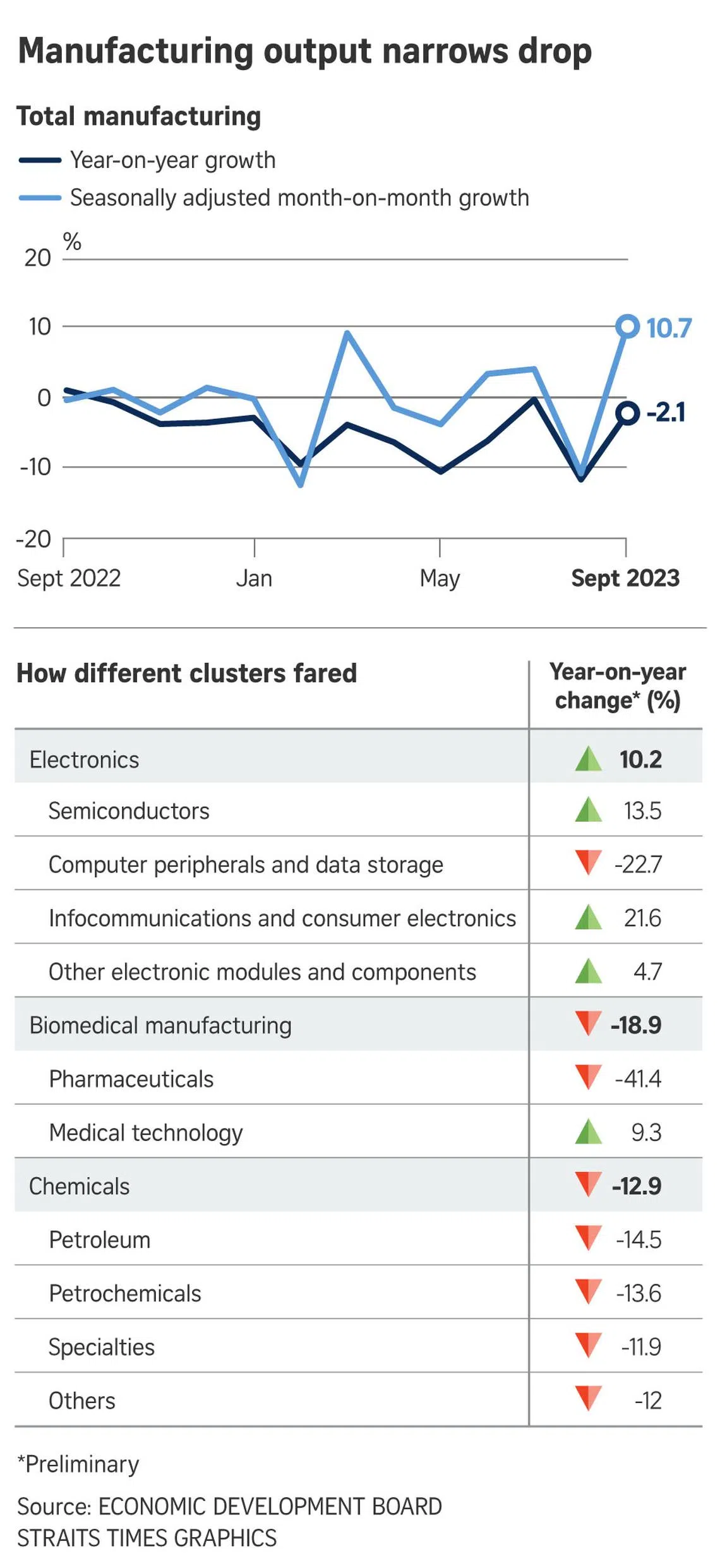Singapore factory output narrows drop in September as electronics recovers
Sign up now: Get ST's newsletters delivered to your inbox

Total factory output fell 2.1 per cent in September, a marked improvement from the 12.1 per cent slump recorded in August.
ST PHOTO: KUA CHEE SIONG
Follow topic:
SINGAPORE – Singapore’s manufacturing performance in September is fuelling hopes of a turnaround after a year-long slump as electronics, and especially semiconductor, demand recovered.
Total factory output fell 2.1 per cent in September, a marked improvement from the 12.1 per cent contraction in August,
The drop, which made for 12 straight months of decline, was also smaller than the 4.5 per cent decline forecast by analysts in a Bloomberg poll.
Excluding the volatile biomedical industry, factory output edged up 0.1 per cent, after falling 2.7 per cent in August.
The key electronics industry saw output grow 10.2 per cent year on year, after shrinking 18.9 per cent in August.
Within electronics, infocomms and consumer electronics production surged 21.6 per cent, semiconductors grew 13.5 per cent, and other electronics modules and components segments rose 4.7 per cent. Computer peripherals and data storage declined 22.7 per cent.
RHB acting group chief economist Barnabas Gan said that Singapore’s manufacturing momentum is expected to strengthen in the current quarter, due to improving global trade winds and the gradual recovery in China-centric economic data.
He said: “We are positive on the electronics, transport engineering and general manufacturing industries in the next six to 12 months.
“There is a material chance for manufacturing growth on an annual basis to turn positive at year-end.”
For September, the biomedical industry was the worst performer, with production plunging 18.9 per cent year on year.
Within the cluster, the output of the pharmaceuticals segment contracted 41.4 per cent on account of a different mix of active pharmaceutical ingredients being produced, compared with a year ago. However, the medical technology segment expanded 9.3 per cent, supported by strong export demand for medical services.
Output in the transport engineering cluster grew 13.2 per cent in September, over the same month in 2022.
The marine and offshore engineering segment led the charge with an expansion of 24.7 per cent due to higher levels of activity in shipyards and increased production in oil and gas field equipment.
The aerospace segment grew 14.8 per cent as a result of higher demand for aircraft parts and more maintenance, repair and overhaul jobs from commercial airlines on the back of strong air travel demand.

In the precision engineering industry, output fell 10.4 per cent year on year, with the machinery and systems segment declining by 7.8 per cent due to lower output of semiconductor-related equipment and process control equipment.
General manufacturing output fell 10.3 per cent over September 2022, weighed down by lower production of batteries and structural metal products.
The chemicals cluster was also in the red, with output falling 12.9 per cent year on year. The petrochemicals and petroleum segments were generally affected by weak market demand, and production in the former was also affected by plant maintenance shutdowns.
UOB economists Alvin Liew and Jester Koh believe it is too soon to call a bottom to Singapore’s manufacturing slump.
“We are taking a more cautious approach, given the still weak external backdrop on tight financial conditions stemming from an elevated interest rate environment.
“We would have to see further improvements in the subsequent electronics manufacturing and Nodx (Singapore non-oil domestic export) prints to conclude that the electronics cycle has indeed bottomed and is projecting a marked recovery likely towards the middle of 2024.”
The economists tip Singapore’s full-year economic growth at 0.6 per cent in 2023, unchanged from their previous forecast.
Earlier in October, the Monetary Authority of Singapore said 2023 growth is expected to come in at the lower half of the 0.5 per cent to 1.5 per cent forecast range.


